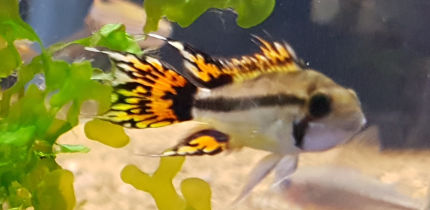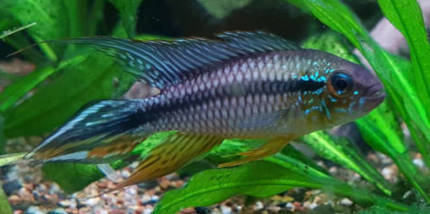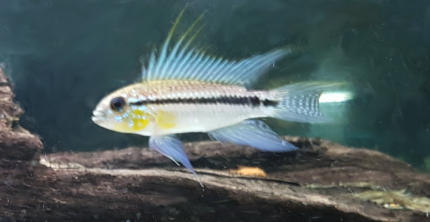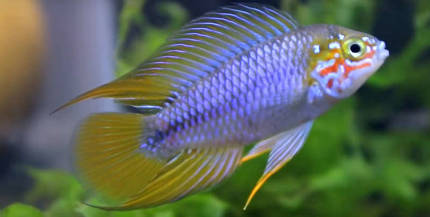About Apistogramma Cacatuoides
Apistogramma Cacatuoides (also known as the Cockatoo Dwarf Cichlid) are one of the most common Apistogrammas in the aquarium hobby. This mean they are easier to find in local pet shops and are generally less expensive than some of the other rarer Apistogramma species.
Apistogramma Cacatuoides are not difficult to keep and with their striking appearance can be a great addition to aquariums.
Fully grown Apistogramma Cacatuoides males reach a maximum size on 3 inches (7.5cm) while females are smaller only growing up to 2 inches (5cm) in size.
Apistogramma Cacatuoides Profile
Origin: Amazon basin including parts of north western Brazil and Peru.
Size: Female: up to 2 inches (5 cm), Male: up to 3 inches (7.5 cm).
Minimum tank size: 20 gallons (75 liters).
Tank region: Bottom half of the tank.
Water temperature:72 - 84 °F (22 - 29 °C)
Water conditions: PH between 5 to 7 is desirable. Soft water with a low TDS is preferred. Commercial bred varieties are less fussy.
Difficulty to keep: Beginner to intermediate level
Apistogramma Cacatuoides Natural Habitat
In the wild Apistogramma Cacatuoides are found in the upper amazon basin in the northwest Amazonas region of Brazil and also in Peru.
Cacatuoides live in slow moving tributaries which are often partly shaded and usually have a sandy bottom and often contain decaying left litter.
Cacatuoides thrive in the diverse ecosystems of the Amazon River basin, particularly in slow-moving tributaries and flooded forest areas. These habitats offer a mix of calm waters and shaded spots, reflecting the natural dynamic of the rainforest.
Apistogramma Cacatuoides species have adapted to densely vegetated environments, finding refuge among submerged branches, leaf litter, and aquatic plants.
Behaviour and Personality
Like many Apsitogrammas Apsitogramma Cacatuoides are quite inquisitive fish and take an interest in their surroundings and what is going on around them. They have a stocky thick set body and might occasionally chase a fish away if it infringes on their personal space, but generally Cacatuoides are a peaceful and chilled out fish.
Apsitogramma Cacatuoides generally stay within the bottom half of the water column and often sift the substrate as they look for food left over food from earlier feedings. At feeding time they will accept food from the any region in the water column and even from the surface providing they are not out competed by larger fish.
Apsitogramma Cacatuoides are a dwarf cichlid and although they are generally peaceful and good community fish they can at times become aggressive - most often towards other males or during breeding.
Males do like to have their own territories, hence it is not recommended to keep multiple males within the one aquarium unless it is quite large (40gal or greater) and well laid out.
If you are after more information on potential Apistogramma aggression and how to reduce it check out our article Apistogramma Aggression And How To Reduce It.
Apistogramma Cacatuoides Male vs Female
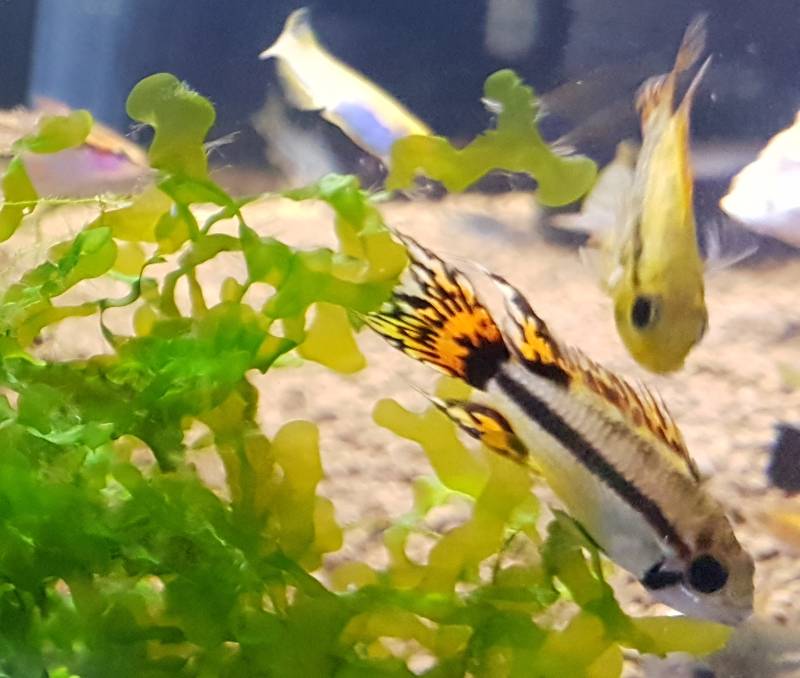
Males
Male Apistogramma Cacatuoides are larger and more colourful than their female counterparts.
The males have very high dorsal fins with elongated rays at the front. They also have extended ventral/pelvic fins and a lyrate tail.
Females
As with other apistogrammas female Cacatuoides are smaller and less colourful, usually a dull yellow or brownish colour. They become bright yellow when breeding.
What to feed Apistogramma Cacatuoides
Feeding Apistogramma Cacatuoides should include providing a diverse diet to ensure their optimal health and vibrant colours.
In their natural habitat, they are omnivores and replicating their dietary needs in captivity is a critical part of maintaining the good health of your Cacatuoides.
A balanced diet should consist of high quality pellets or flakes specially formulated for tropical fish which provide the required nutrients. Additionally their diet should be supplemented with live or frozen foods like brine shrimp, bloodworms or daphnia.
Variety is key, as it caters to their nutritional requirements and encourages their natural behaviours – such as chasing and eating live foods.
For more information on what to feed you Apistogrammas see our article Best Foods For Apistogrammas.
When breeding protein rich foods such as brine shrimp enhance their reproductive health and encourage breeding.
I recommend feeding them small amounts two or three times a day because their small stomachs can process limited quantities at once. Avoid overfeeding as uneaten food can lead to poor water quality.
Apistogramma Cacatuoides Colour Variants
Colour variants of Apistogramma Cacatuoides are still the same species (ie Cacatuoides) however have been line bread to enhance the fishes colours.
Names such as "Super Red" or "Triple Red" are a commercial name used to describe the colour of the fish and to make them sound fancier and more desirable.
"Double Red" usually means red on the Dorsal fin and Caudal fin (tail), while "Triple Red" includes red on the Anal fin too.
Apistogramma Cacatuoides Super Red
"Super Red" suggest more red than a "Triple Red", usually with red on the ventral fins.
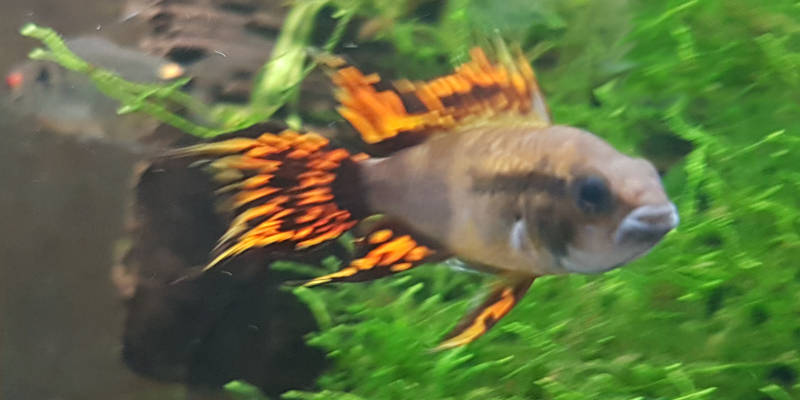
Apistogramma Cacatuoides Orange Flash
The term "Flash" in "Orange Flash" refers to the case where the fins do not have the black patterning and are pure orange.
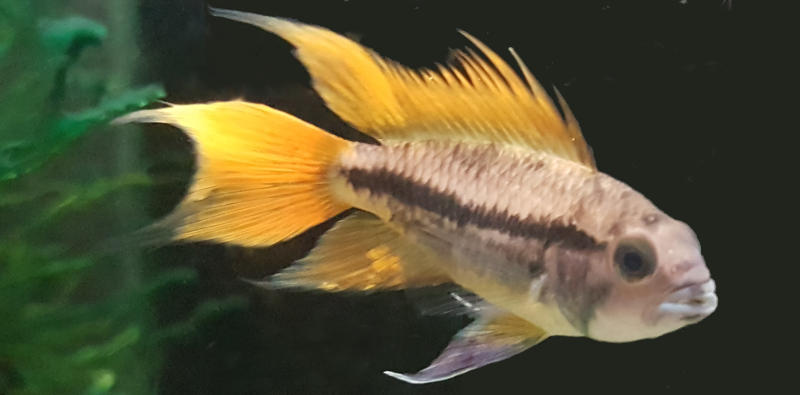
Apistogramma Cacatuoides Aquarium Setup
Tank Size
As Cacatuoides are one of the larger species of Apistogramma a minimum tank size of 20 gallons (75 litres) is recommended, this would also allow for some tank mates, such as tetras. Refer to below tank mates section.
You could also keep a trio (1 male + 2 females) in a 20 Gallon (75 litre) tank, however the tank would need to be setup appropriately in order to minimises any possible aggression.
Substrate
In the wild Apistogramma Cacatuoides are found in shallow tributaries with sandy bottoms. Apistogrammas also enjoy sifting the sand from time to time as they look for food.
So a sand substrate which mimics the Apistogramma Cacatuoides natural habitat is recommended.
Aquarium Layout
Cacatuoides (like all apistos) appreciate some hiding places within the aquarium and objects which break up line of sight. This can be achieved by adding driftwood, rocks and plants to the aquarium.
These separated areas of the tank also provide separate territories should males get aggressive such as during breeding.
For more information on managing aggression see - Apistogramma Aggression And How To Reduce It.
Best Apistogramma Cacatuoides Tank Mates
Other non aggressive fish are best. Tetras such as Ember Tetras, Loreto Tetras (and many more), as well as Dwarf Pencilfish are generally good choices.
For more detail on selecting appropriate Apistogramma tank mates check out or detailed article, Apistogramma Tank Mates.
Conclusion
Apistogramma Cacatuoides are a fantastic Apistogramma with great personalities and are available in different colour varieties.
In many cases they make a great addition and provide an extra point of interest in an aquarium.
